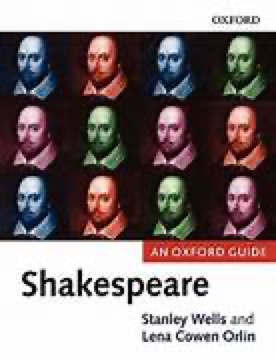Academic Review - An Oxford Guide: Shakespeare
January/23/2017 10:55 PM Filed: Academic Reviews

Author: Stanley Wells and Lena Cowen Orlin
(Oxford University Press)
An Oxford Guide: Shakespeare
This book is an excellent secondary reference source. Stanley Wells and Lena Cowen Orlin present an overview of Shakespeare’s career from historical and literary standpoints, providing detailed bibliographies. Numerous experts contributed, creating an unbiased collection of theses. Published in 2003 by Oxford University Press, this compilation is similar to an encyclopedia. Divided into four parts, the text covers Shakespeare’s life, genre, criticism, and afterlife.
Martin Ingram, a professor at Brasenose College, writes an interesting essay titled, “Love, Sex, and Marriage.” Despite the Renaissance notion that marriage is preferable, the statistical reality was nothing close to what church leaders and conservatives proposed. Pressure for a woman to marry, and unfortunate consequences of coerced or thwarted unions, drove much of Shakespeare’s drama, comedy, and tragedy.
“Demographic calculations indicate that at any given moment in this period up to forty-five percent of women were either not yet married or widowed, while the proportion of women who never married was on the increase and was to exceed one in five shortly after Shakespeare’s death,” Ingram writes.
Though experts state the playwright’s work surpasses time and place, Ingram does not take scenes out of Elizabethan context. “While many of the issues still have enormous resonance in the present day, they can be fully understood only in the very different cultural context of Shakespeare’s own time.”
Shakespeare was perceptive and saw women’s rights advocates emerge long before the majority took feminist concerns seriously. Likely, he could foresee the long-term impact of his dramatic statements, and it is certain he anticipated upheaval and transition.
William C. Carroll, a professor at Boston University, presents “Romantic Comedies,” an overview of Shakespeare’s strongest plays and a lighthearted reflection of English Renaissance society. “The romantic comedies are termed ‘romantic’ in part because their plots and major themes involve love and desire,” Carroll explains. “They are related to the so-called ‘romances’ in that both types of play have similar plots, typically involving some frustration of true love, a journey by a lover, improbable or even magical events, and a resolution in marriage or the promise of marriage arising from some discovery about identity.”
This winning formula drew audiences to the theater in the sixteenth and seventeenth centuries, and today, mesmerizes people at the cinema. Romance novels, trashed by critics as frivolous, utilize plot structure familiar to Shakespeare. The playwright’s misunderstandings, mistaken identities, and unlikely scenarios are hailed as creative art, yet contemporary writers dare not proceed along the same plot lines.
Though scholars are aware Shakespeare practiced his craft for money, academics ignore the monetary aspect. The college crowd appealed to Shakespeare—many were his comrades—but he acquired his education through independent reading and experience. His success is not based on how much he knew, but on how much he sold.
Bruce R. Smith, a professor at Georgetown University, contributes a thesis titled, “Studies in Sexuality.” The Elizabethan audience may have been different in mores and morals, but people manifested timeless instincts. “Bodies are as essential to plays in performance as electric signals are to videos. Actors have bodies, listeners/spectators have bodies, and the transactions among them in the course of a performance are energized by various forms of desire,” Smith says.
Libido and need to create a suitable environment to raise children influence the behavior of both genders, providing an eternal basis for plots. By placing obstacles to fulfillment, stories can be manipulated, scene after scene, until the couple does or does not reach the culmination.
David Kathman, a freelance scholar, debates the legitimacy of Shakespeare’s byline in “The Question of Authorship.” He makes a convincing case against those who claim Shakespeare did not write the works we now attribute to him. Numerous theories have denied the authenticity of the name “William Shakespeare,” even asserted the Bard was someone else. Some believe a group of playwrights and poets wrote under one name.
“Anti-Stratfordians try to discount the evidence for Shakespeare’s authorship using a variety of tactics, most of which involve distorting the facts and their historical context,” Kathman states. “In addition to replacing evidence with conspiracy theories, anti-Stratfordians usually attack Shakespeare personally, sometimes quite viciously. They depict Stratford as an uncultured cesspool which could never have produced a great writer, and Shakespeare himself as a greedy, semi-literate burgher.”
Although the playwright did collaborate with other writers on a few plays, the academic community does not take the authorship question seriously. “For most anti-Stratfordians, these attacks on William Shakespeare of Stratford have one primary purpose: to clear the way for their own candidate as the ‘real’ Shakespeare,” Kathman adds.
Social life and love in Renaissance England infiltrate every scene and every line of Shakespeare’s canon. Continued evaluation of this famous man brings to light modern attitudes toward the Elizabethans, what we’ve learned from them, and what we condemn in their behavior. This obsession with every word he wrote has led to new discoveries, while scholars enlighten one another with conjecture.
Would Shakespeare have appreciated this excessive pondering? No one will know for certain, but this acclaim has kept his name alive.